NYC’s Forgotten ‘War on Christmas Trees’
Discover how an obscure holiday crackdown affects festive street vendors today!


The perpetual rivalry of New York City’s skyline has always most obviously been about height, as evidence by the earliest World Building in 1890 to the latest One World Trade Center. With all the talk about Donald Trump, we’re focusing this compilation about the city’s most over the top buildings – be it in decoration, materials, or other factors – that beat out Trump Tower, in our opinion.
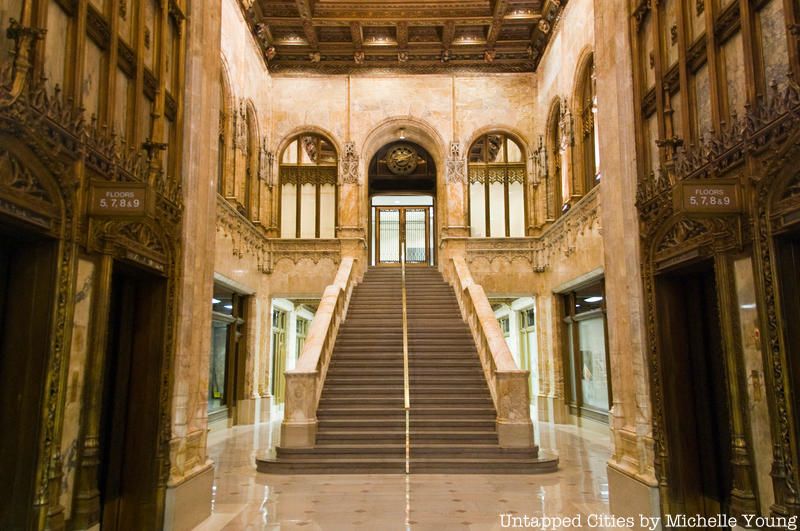
The Woolworth Building soars above City Hall Park on a full-block site on Broadway between Park Place and Barclay Street. Commissioned by retail tycoon Frank W. Woolworth, who controlled almost six hundred “five and dime” stores, the building was completed in 1913 and designed by architect Cass Gilbert. Once the tallest building in the world, today, the 792 feet tall skyscraper is still one of the thirty tallest buildings in New York City. It was designated as a National Historic Landmark in 1966, and a New York City landmark in 1983.
The building’s neo-Gothic style resembles the Gothic cathedrals in Europe, giving its nickname “The Cathedral of Commerce”. The grandeur and authority of the corporate tower is expressed on the elaborate exterior cladded in cream terra cotta panels as well as vertical piers that accentuate the verticality of the structure. Lesser known is that the top of the Woolworth Building used to be layered with gold leaf, a comparatively inexpensive method of conveying luxury as gold can spread thinly and cover over a large surface area.
These days, the closest one can get of the top of the tower is by buying one of the $100+ million apartments, but on our exclusive tour of the Woolworth Building led by the great granddaughter of Cass Gilbert, visitors can view the grand symmetrical cruciform lobby, featuring barrel vault mosaics, a stained glass skylight, veined marble walls, bronze furnishings, and plaster grotesques. Although not lined with gold, visitors can still see the glass tessarae and the murals of Commerce and Labor on the mezzanine levels, which are well preserved.
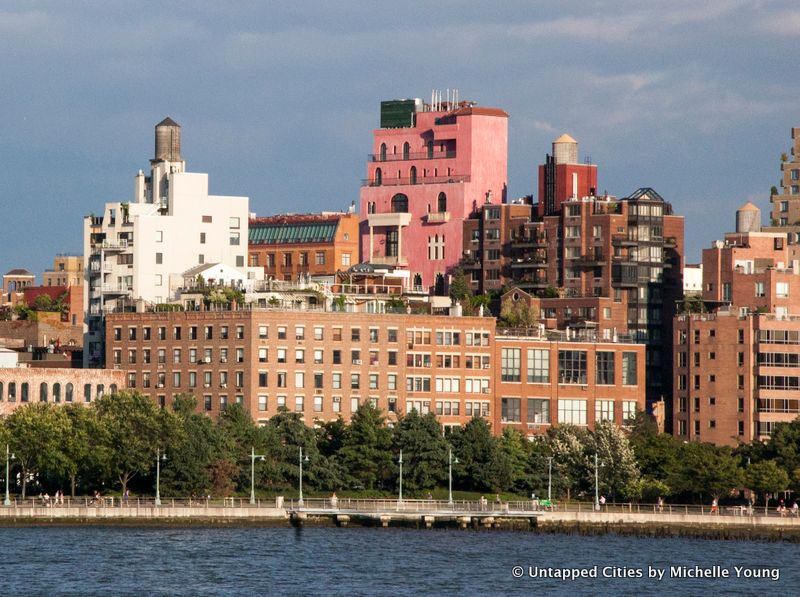
The Palazzo Chupi in West Village distinguishes itself from its neighbors not by sumptuous facade ornamentations, but by a vibrant pink facade that is hard to miss. Owner Julian Schnabel is a prolific artist, designer and filmmaker, who also designed the Northern Italian style Palazzo Chupi, constructed in 2005-08. The kooky building is named after the popular Spanish brand “Chupa Chups” lollipops, and also Schabel’s byname for his wife “Chupi”.
The Palazzo Chuppi has received much criticism from the public, in particular Andrew Berman, executive director of the Greenwich Village Society for Historic Preservation, who described it as “woefully out of context and a monument to this guy’s ego” and “an exploded Malibu Barbie house.” Since then, the color of the structure has changed from a bright fuchsia to one that resembles the “Pepto Bismol” coral color. Although the color was “toned down,” the 170 feet tall structure still dwarfs most of its neighbors in the West Village historic district, which are restricted to 75 feet in the new buildings ordinance in Greenwich Village.
Read about 9 other buildings that have changed colors in NYC.
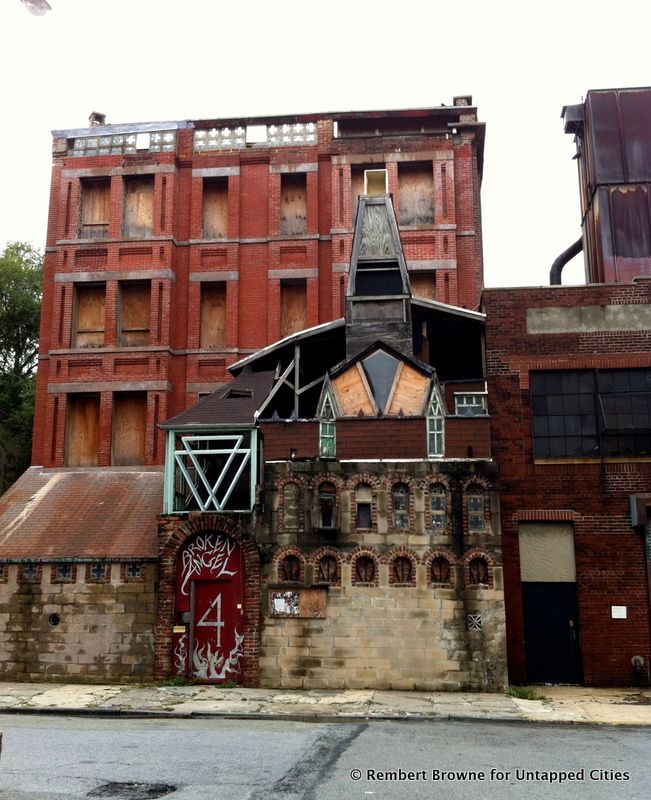
The Broken Angel House was perhaps one of the most eye-catching and bewildering urban myths in Clinton Hill, Brooklyn. Once located at the intersection of Downing and Quincy street, the four story building was a quirky juxtaposition of colorful glass facets, crooked arches, bizarre balconies, and irrational metal works. The Broken Angel House was most well known for its appearance in Block Party, a documentary film hosted and written by comedian Dave Chappelle, and directed by Michel Gondry.
The building was owned by self-taught artist-architect Arthur Wood and his wife, Cynthia, who bought the property in 1979 for only $2,100. Named after an unwanted cherub statue the couple found on Staten Island, the Broken Angel House was a true “work in process.” Over more than two decades, the couple turned the abandoned trolley factory into a DIY neighborhood spectacle using only materials they or their children found in dumpsters or on the streets.
Declared unsafe after a fire in 2006, and lost to a developer in 2007, the building was finally filed for foreclosure in January 2009. The building was bought by developer Alex Barret in January 2014 for $4.1 million, and was completely demolished in May the same year. Renamed as “4 Downing,” the eight-unit luxury condominium building is not any different from the neighborhood’s other new million-dollar condos.
To this day, owner Arthur Wood is fighting, albeit in vain, to get his property back.
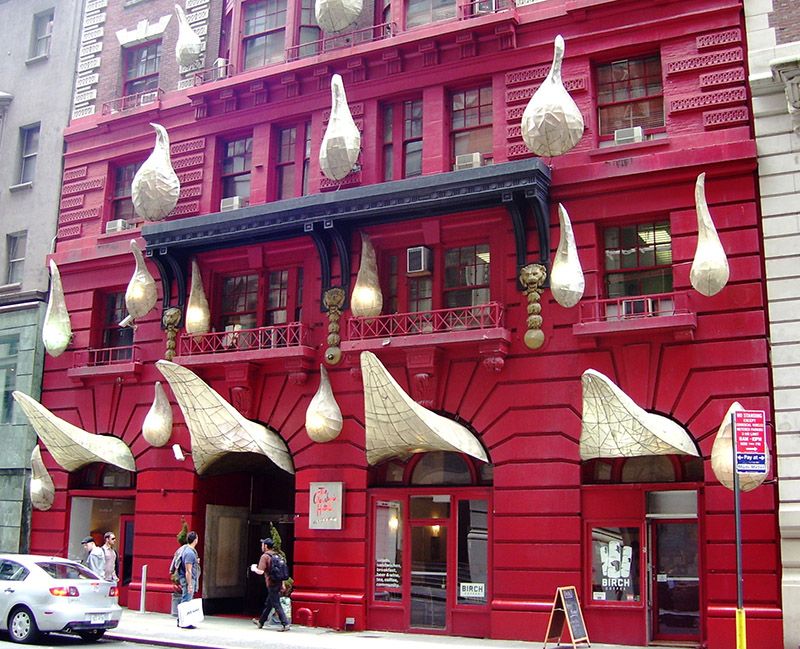
Image via Wikimedia Commons by Beyond My Ken
The former Gershwin Hotel in New York’s Flatiron District boasted a uniquely whimsical facade that was instantly recognizable. The area where the structure was built was known as “Tin Pan Alley” in the late 19th and early 20th centuries, where many performers, musicians and songwriters converged. Among these musical figures was composer George Gershwin, best known for his orchestral compositions Rhapsody in Blue and An American in Paris, and which the Gershwin hotel was named after.
Designed in Beaux Arts style, the blood red colored building facade was adorned with eccentric Dali-esque giant white horns, a remarkably unforgettable sight.
Triumph Hotels acquired the property in early 2014 and the historic hotel, now known as The Evelyn, has been upgraded with references to its artistic and bohemian heritage. The quirky facade were sadly removed in the renovations.
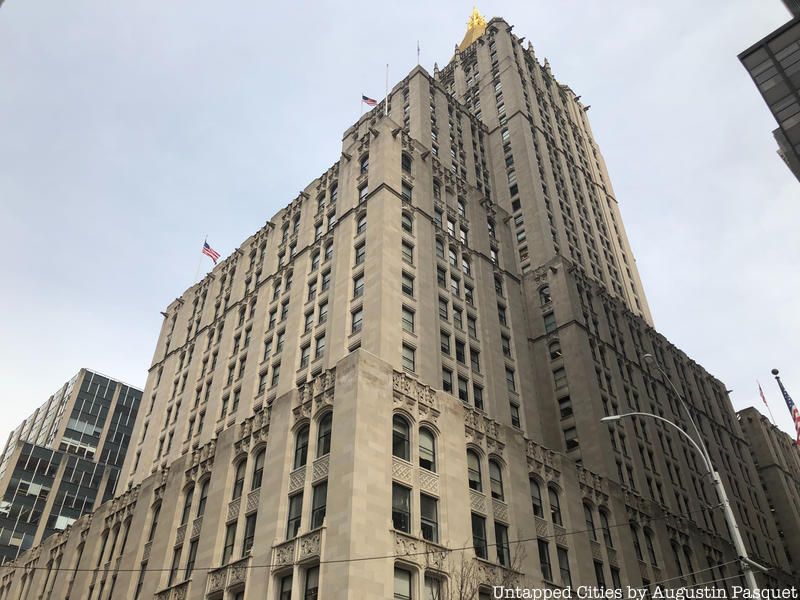
Perhaps not as impressive as the Woolworth Building from the ground level, the New York Life Building is Cass Gilbert’s last significant building in New York City. The building rises 615 feet from the ground, and is topped by an impressive pyramidal gilded roof, where six stories of mechanical services are enclosed in.
Located on 51 Madison Avenue, across from Madison Square Park, the New York Life Building is a monumental building housing the New York Life Insurance Company’s headquarters and occupies the full block between 26th and 27th streets, Madison Avenue and Park Avenue South. From its inception, the building has been a symbol of corporate authority as well as a powerful advertising image.
The glimmering tower roof was reconfigured in 1966-67 where the original copper and gold leaf was replaced by golden ceramic tiles. Nevertheless, it has remained highly visible among its rivals across the New York skyline.
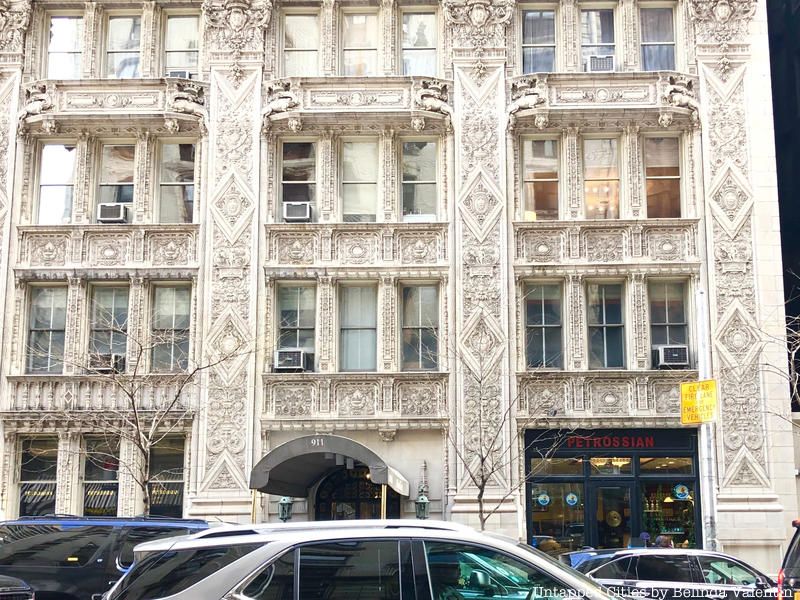
Officially known as Alwyn Court, the incredibly ornate Petrossian Building took its name from the Parisian restaurant on its ground floor. The renowned restaurant serves a wide range of high end delicacies, including caviar, foie gras, and smoked fish. Located at West 58th Street on the corner of Seventh Avenue, the 12-story apartment building is just near Carnegie Hall.x
The building was built between 1907 and 1909, and was designed by Harde & Short in French Renaissance style. The Alwyn Court was designated as a New York landmark in 1966, and added to the National Register of Historic Places in 1979. Its most distinguish feature is the terra-cotta ornamentation in the Francis I-style that covers the entire facade. Without splurging on the luxurious cuisines at Petrossian, the building’s glorious details give passersby a taste of the “unsurpassed gourmet experience” within.
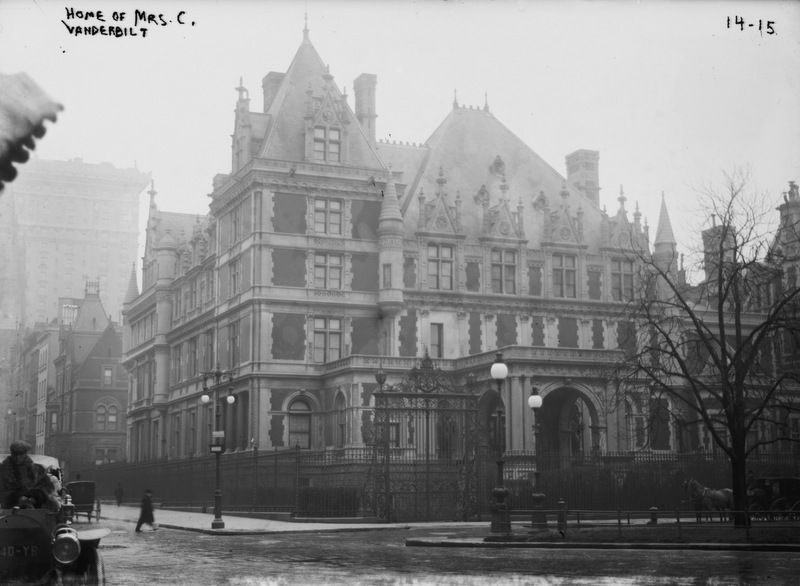
Front side of Vanderbilt Mansion. Image via Library of Congress
Any list that has the words “over the top” would not be complete without mentioning the Vanderbilts. The family built their success upon Cornelius Vanderbilt’s shipping and railroad empire and was prominent during the Gilded Age. Up until the mid- 20th century, Cornelius Vanderbilt’s descendants continue to build extravagant mansions and chateaus in locations such as Newport, Rhode Island and Upstate New York. Despite the family’s decline, the name Vanderbilt has become an emblem of wealth and power.
In 1882, Cornelius Vanderbilt II used a $5 million inheritance from his father the Commodore to purchase and demolish three brownstones on the southwest corner of 57th Street and 5th Avenue to build his new mansion. In 1893, the same mansion was expanded, and although considered as “restrained” by Vanderbilt standards, was reported as the largest single family house in New York City at the time.
Following the downturn of the Vanderbilt empire, the mansion was sold to Braisted Realty for around $7 million in 1926. Today, the property that sits on the original address of the Cornelius Vanderbilt II mansion has become the department store Bergdorf Goodman, and remnants of the structure can be found in various locations within New York City.
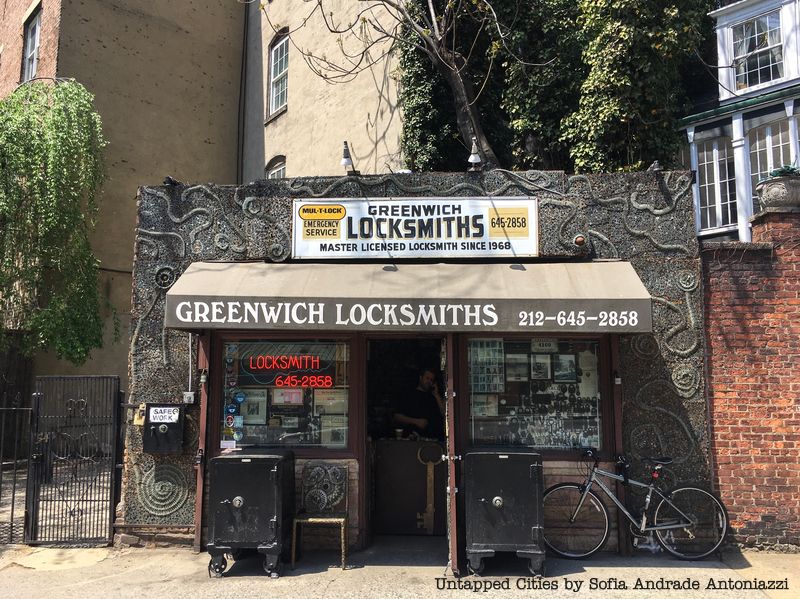
The Greenwich Locksmiths is a tiny store just south of Commerce Street in West Village. Not involving famous artists, architects, or sophisticated structural engineering, the wacky storefront design deems to be one of the most over the top storefronts in New York City. Installed by owner Phil Mortillaro in 2011, the store was converted from an ordinary brick veneered facade to the golden bronze facade with intricate details. From a distance, it looks like a series of metallic spiral and patterns across the facade. Looking closely, the patterns reveals intricate placements of thousands of keys.

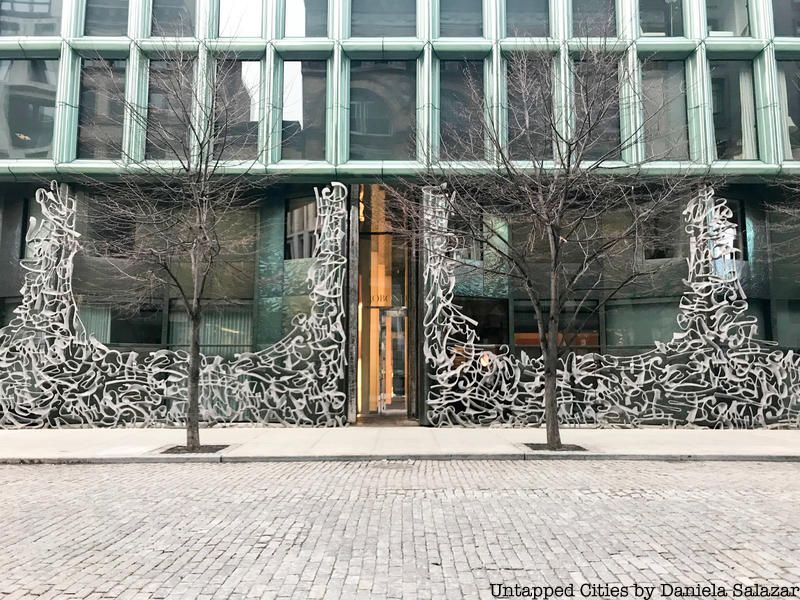
Luxury condo 40 Bond Street in NoHo, developed by Ian Schrager, Handel Architects, designers Herzog & de Meuron and Germany-based gate designer EXYD, has a 140-foot filigree gate, in the style of Antonin Gaudi. The ornate aluminum gate is the entrance to triplex apartments that rise from the first to third floor, still allowing sight lines inside and outside. Ironically, as mentioned in our previous article about decorative window grates in New York City, the uber-designed art piece has become so iconic, tourists come to photograph it – making it possibly the most high profile privacy barrier in the city.
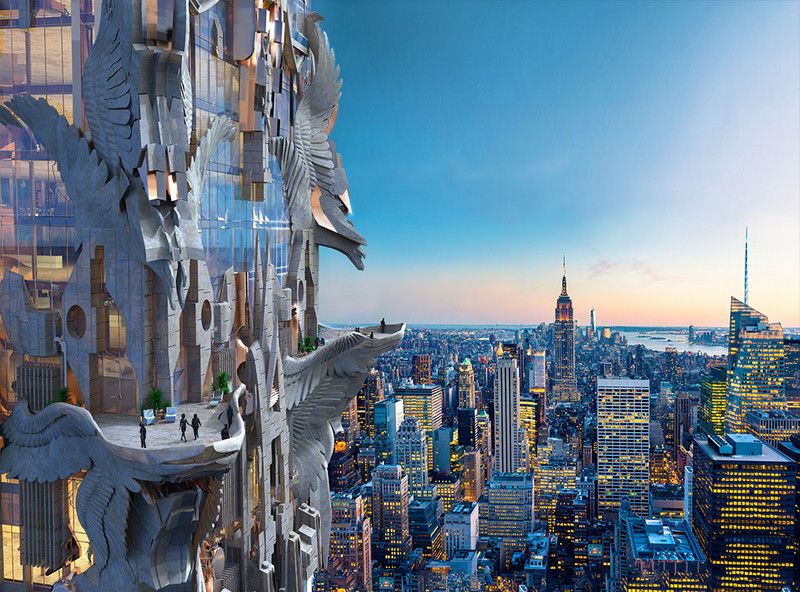
While this skyscraper on 57th Street is merely fantasy at this stage, architect Mark Foster Gage received quite a bit of press over it in late 2015. The 102-story residential building is decked out in all types of ornaments and architectural embellishments that would vastly reshape the skyline for Midtown’s Billionaires’ Row, if built.
According to Gage’s website, “each unit has its own unique figurally carved facade and balconies that frame particular features of the surrounding urban and natural landscapes.” Integrating sheet-bronze and brass into limestone-tinted Taktl concrete panels, some of these whimsical features include giant birds spiraling down the building, huge fans and propellers that look like they’ve been taken out of a plane and finally, atop the building, a “temple-like observational platform which is then crowned by a golden wreath-like structure fit for any victorious Roman general.” See more images here.
Next, check out the world’s tallest buildings that have been in New York City and the tallest buildings existing and planned in NYC.
Subscribe to our newsletter